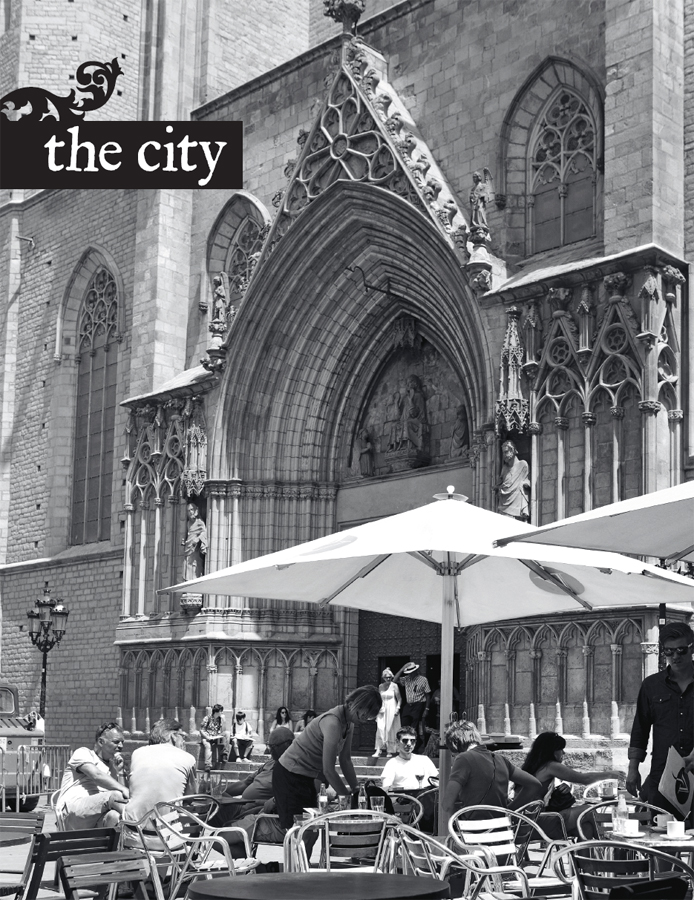Contents
INTRODUCTION
People are always asking me how I came to leave the space and lifestyle of Australia to live in the Spanish urban sprawl the people soup that is Barcelona. The simple truth? The idea of moving to another hemisphere in my mid-thirties, taking my teenage daughter Ruby along for the ride, was not nearly as frightening as the thought of never learning to speak another language or really understanding any culture other than my own.
Spain, and particularly Barcelona, had always been a fantasy destination but finally, in 1998, I had the chance to go there with Ruby during the blissful first throes of my relationship with Michael (my now-husband), who wanted to introduce me to the other love of his life Spain.
He filled my head with fanciful dreams. He would take me to the most famous champaeria, Champagnera Can Paixano in downtown Barcelona, for hamburgers of foie gras and blue cheese. We would eat the best tapas in the city, drink the best cocktails this side of New York and see the most amazing surrealist architecture in the most fabulous city on earth. Michael has a tendency toward hyperbole and Im prone to believing it. Such high expectations might be dangerous goods to take on a trip but I didnt care. I drank it all in and let him carry both of us away.
Before seeing it up close and personal as we drove around the Iberian Peninsula for six glorious weeks, my only points of reference to Spain were the clichs the bull-fighting, hand-clapping, flamenco-dancing, sombrero-wearing, gesticulating Latin lovers of life who favoured late nights, long lunches and afternoon naps.
Much of this I found to be true. But I also discovered a range of different cultures, and not one but four different language barriers spread across the country, with Spanish the lingua franca being the communication thread that linked them all.
We travelled from the lush mountains of El Pas Vasco, the Basque country, where Vikings are born and the steaks are served in Flintstone proportions; across to Galicia, where the weather can be bleak but the people are far from cheerless and the seafood is exquisite; down to spaghetti-western country where proud Castillian hearts beat out rhythms of unity and free tapas abound; then we slipped languidly down south to Andalusia where time slowed, little got done and tomorrow never came. Finally, back in rebellious Catalonia, home to Barcelona and much of the countrys money and great art, we said farewell. But I had fallen under Spains spell and before we even left the tarmac I was making plans to return.
In 2003, we packed up and transported our lives from Sydney to Barcelona. Four months later, I accidentally opened a restaurant called EMU Bar.
Working in the Australian food industry for over a decade gave me a solid base but living in Spain has allowed me to explore one of the most popular and accessible cuisines from the inside out.
From the moment I arrived, I began collecting classic Spanish recipes and creating new ones. In this book youll find those, as well as recipes from my favourite places to eat a restaurant, bar or, more often, a friends home, complete with the secrets passed down through generations. All of these recipes and thoughts were inspired by eating, living and dreaming in Spain, and cooked up with love in my Barcelona kitchen.
Honey & rosemary glazed figs wrapped in Spanish ham
Higos con miel y romero envueltos de jamn
The marrying of honeydew melon with salty jamn is common practice in Spain during the summer months. But why stop there? These aromatic caramelised baked figs add yet another dimension to an old favourite all the way through to autumn. Theyre truly addictive to begin or round off a meal along with a glass of crisp cava.
SERVES 4
12 fresh figs, halved
20 g ( oz) butter
2 tablespoons honey
2 large rosemary sprigs, plus extra leaves for serving
6 slices Spanish ham (), halved lengthways
Preheat the oven to 220C (425F/Gas Mark 7).
Put the fig halves, flesh side up, onto a baking tray lined with baking paper. Set aside.
Heat the butter and honey in a small saucepan over low heat, until the butter melts. Add the rosemary sprigs and cook gently for a few minutes, to infuse the butter and honey syrup with the flavour of the herb.
Spoon the honey and rosemary syrup over the figs.
Wrap each fig with a piece of ham and secure with a toothpick.
Bake the figs on the middle shelf of the oven for 10 minutes. Serve warm or at room temperature, sprinkled with rosemary leaves.
Croquettes with Spanish ham
Croquetas de jamn
You will need to start this dish a day ahead of serving to allow time for setting. The trick to the perfect croquette is all in the making of this exquisitely creamy bchamel. And the secret to keeping it inside the croquette? Double-dipping in breadcrumbs! Serve these delicious morsels at their very best freshly cooked and still hot.
MAKES 30
34 handfuls fine dry breadcrumbs
1 large handful chopped flat-leaf parsley
3 free-range eggs, whisked
vegetable oil, for deep-frying
FOR THE BCHAMEL
200 ml (7 fl oz)
1 litre (35 fl oz/4 cups) milk
1 tablespoon olive oil
120 g (4 oz) unsalted butter
120 g (4 oz) plain (all-purpose) flour
6 slices Spanish ham (), finely diced
ALTERNATIVE FILLINGS
Instead of ham, you could use left-over roast chicken or turkey, grated cheese, flaked salt cod, left-over cooked vegetables, regular ham or any cured meat, such as salami.
To make the bchamel (do this on the previous night), heat the stock and milk in separate saucepans until hot. Set aside.
Put the olive oil and butter in another saucepan over medium heat. When the butter starts foaming, add the flour and cook, stirring, for a few minutes. (This is a roux the base of all white sauces.)
With the pan still over the heat, add the hot milk to the roux and whisk vigorously until smooth. Reduce the heat to low and keep whisking to avoid lumps forming. Add the hot stock and cook, whisking continuously, until the sauce boils and is the consistency of very thick cake batter (about 20 minutes).
Allow the sauce to cool a little. Season, stir through the ham and spoon the bchamel sauce into a deep dish. Cover well and refrigerate overnight.
To make the croquettes, combine the breadcrumbs and parsley in a bowl. Put the whisked egg in a separate bowl.
Remove the prepared bchamel from the fridge. Shape a tablespoon of the bchamel into a ball. Dip the ball into the egg until well coated, then roll in the breadcrumbs. Dip this coated ball into the egg again, and roll in the breadcrumbs again. Set aside on a plate and repeat with the remaining bchamel, egg and breadcrumbs.




















